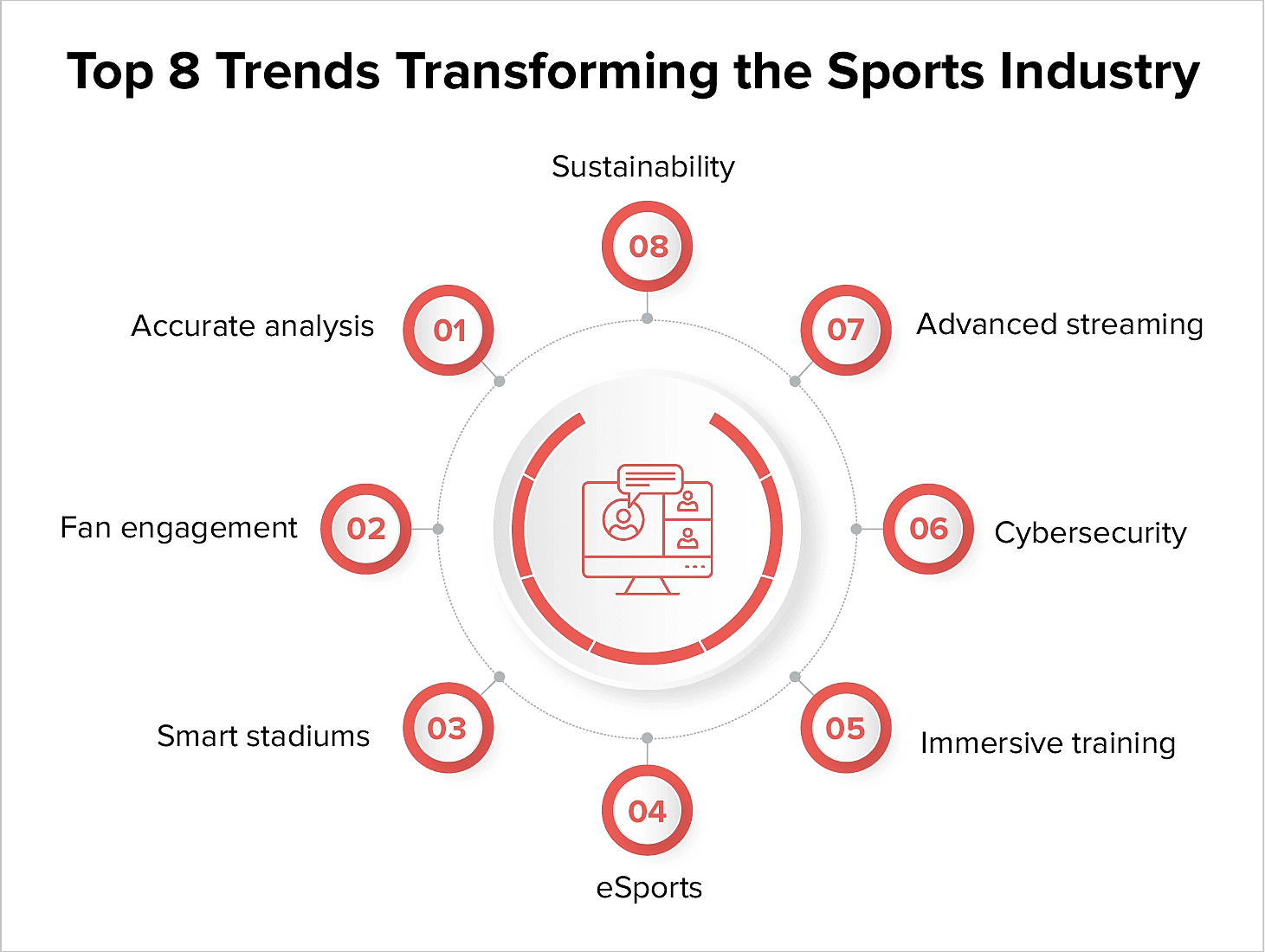
With technology rapidly gaining traction, the sports industry has witnessed advanced sports tech trends that bring about significant change. Technology has become really important in sports nowadays. It's changing how athletes train, compete, and connect with fans. Sports is no longer confined to TV screens and stadiums. The multi-faceted landscape of sports is now an essential part of the modern society.
As we move forward, keeping up with the latest trends in sports is extremely important. These updates are important for both sports industry professionals and sports enthusiasts. Further, in this insightful blog, we will explore recent trends in the sports industry. We will also discuss how these transformative trends in the sports industry are shaping the game.
Sports Technology and its Impact on the Industry
The dictionary definition of sports technology simply means the integration of advanced technology into sports. This technology is used to improve athletic performance, training, analysis, and the overall experience for fans as well. From wearable technology to virtual reality technology, this industry encompasses it all.
The global sports technology market is expected to grow at a CAGR of 20.8% between 2023 to 2030. Technology-based sports services drive a better user experience and increase audience involvement. The growing adoption of the latest technology, like artificial intelligence, has also contributed to the latest trends in the sports industry.
The continuous evolution and innovation in sports technology enhance the performance and safety of athletes and significantly improve the experience for fans. As we look to the future, it's clear that these technological advancements hold the potential to refine further and advance the sports tech industry. By pushing the boundaries of what's possible, we can anticipate even more sophisticated and integrated solutions. The future trends in sports tech will continue to revolutionize the way sports are played, watched, and experienced globally.
Impact on the industry
The latest trends in the sports industry are powered by advanced technology. The technology used in sports is not only beneficial for the athletes but has also transformed the sports entertainment industry. Here’s how the future trends in sports technology can change the course of the game.
1. Enhances athlete performance

Technological innovations allow athletes to sharpen their skills beyond field training. Smart wearable devices offer real-time data about their heart rate, oxygen levels, and more. This data can be used to tailor the regime for peak performance in the game.
2. Improving viewer experience
Advancements in televised sports can enhance the viewing experience for all sports fans. This technology offers an immersive experience for sports fans. Fans can enjoy features like real-time data analytics, live sports commentary, replays, and much more.

3. Sports tech fuels recovery
Technology in sports can be harnessed to speed up medical treatment for athletes. Furthermore, the latest sports tech helps coaches and trainers to prevent injuries. With the advanced gadgets, trainers can ensure preventive care for their athletes on the field. From portable heart rate monitor apps to advanced recovery systems, technology can have a greater impact on health.
4. E-sports and virtual competitions

E-sports are extremely popular, attracting millions of viewers and participants. Advanced technology can turn competitive into a spectacular sports event for all. For instance, virtual competitions like NBA 2K and Formula E Racing are extremely popular among users.
2024’s Vision- Top 8 Trends Transforming the Sports Industry
Tech-driven innovation has significantly impacted the sports industry. As the global sports industry continues to navigate this transformation, MobileAppDaily’s 2024 outlook will explore 8 key sports tech trends to look out for in the sports industry.

1. Performance Analytics
Trainers and athletes often strive to understand the best practices for acing the game on the field. Advanced performance analytics tools can measure and analyze huge amounts of data. This research can help athletes to identify the areas that need improvement in their strategy.
Video and motion analysis can help trainers and players understand the correct positioning for best results. For instance, athletes can track their movement and involvement, the time of a particular action, and other similar patterns to improve their performance.
Furthermore, wearable technology also provides detailed insights into athletes' actions, force, and accuracy. Smartwatch-embedded sensors can improve decision-making before and during the game.
2. Fan engagement
Building relationships with fans is extremely important for athletes. From buying merchandise to supporting sports events, fans’ contribution is necessary. Live sports events use immersive technology to engage and entertain their fans. Fan engagement can also be prioritized in Esports.
Fan platforms can foster a community of sports enthusiasts. These platforms can facilitate the exchange of sports highlights and more. Fan clubs can also increase fan engagement by implementing blockchain technology for transparent communication.
Additionally, staying updated with the latest sports news and trends is crucial for fans across the globe. This is where accessing the best sports news app becomes invaluable. Such apps not only keep fans informed about live scores and the latest news but also enhance the overall sports following experience. Other advanced tools like biometrics, AI chatbot apps, and other similar technologies can support close engagement with fans.
3. Immersive Training
Immersive training techniques are essential for stimulating an actual match-like environment. With advanced virtual reality in sports, players can train themselves in the virtual world. To further enhance this experience, sports technology companies can use 3D sensor technology to offer a real feel of the stadium.
Additionally, by leveraging the future of virtual reality technology, soon sports fans will be able can experience the actual stadium from anywhere with its sound, sight, touch, and even smell.
4. Esports
The advances in next-generation solutions in the industry have contributed to the popularity of esports. With quick and easy smartphone access, the popularity of free-to-play competitive games has also increased. An excellent example of esports success is PUBG mobile. Other competitive games like Fortnite, Counter-Strike, and League of Legends follow.
Some of the best fantasy sports games use advanced technology to offer a unique experience to their users. AI and machine learning provide in-depth game data analysis, which benefits bookmakers and betters.
5. Smart Stadiums
Stadiums are the best place to offer an immersive experience for sports fans. However, many fans now prefer to watch their favorite tournaments at a more convenient time. To help sports fans ditch traditional TVs, there are alternatives like the best football streaming apps, cricket streaming apps, and more. Sports tech startups can integrate advanced technologies to provide an unparalleled in-venue match experience.
While conducting an event, AI-based crowd sentimental analysis can be conducted to quantify the level of fun attendees are having at the event. Additionally, stadiums can use drones to streamline snack delivery and venue cleaning.
Furthermore, Internet of Technology (IoT) services can significantly improve stadium connectivity and bandwidth. This supports fast check-ins and quick navigation of the parking spots. IoT connectivity also allows the audience to use any app without waiting.
For example, the Mercedes-Benz Stadium in Atlanta, Georgia, uses new tech like really good Wi-Fi, changing digital signs, and easy-to-use mobile apps to make the fan experience better. This means fans can move around more easily, buy food faster, and get into the stadium more smoothly, making their time at the stadium much better.
6. Advanced Streaming
Increased digitalization facilitates sports broadcast globally. Many broadcast networks like 1xbet in India thrive to offer a personalized viewing experience for their users. These channels stream sports events in HD quality while maintaining a high streaming speed.
Live streaming apps and OTT platforms deliver streaming on all internet-enabled devices. Additionally, VR platforms can be used to ensure an in-depth experience for users. Using advanced trends and technology in sports can maximize the quality of broadcasting for all viewers.
7. Cybersecurity
With the growth of technology in the sports industry, the threats to cybersecurity increased. Athletes’ personal data, high budgets for sports events, and streaming platforms are all at the target of hackers. Sports organizers must strive to ensure the protection of the venue and attendees.
This can easily be implemented by adopting expert cybersecurity tips, using protective technologies, and providing optimal cybersecurity training for employees. Installing e-mail defense systems can prevent phishing attacks. Furthermore, blockchain technology can be essential for purchase protection and fan data security.
8. Sustainability
Startups are looking for new and innovative ways to make the sports industry more sustainable and safe for the environment. As stadiums require large amounts of electricity, pairing up sports technologies with renewable resources is a more efficient way. For instance, Green stadiums. These are not only suitable for the environment but also reduce the cost of fuel and energy.
Athletes should prefer wearing eco-friendly jerseys and other sportswear to promote sustainability. Stadiums can also recycle leftover food to reduce wastage.
Virtual Reality and Augmented Reality in Sports
Virtual Reality (VR) and Augmented Reality (AR) are changing how fans play and enjoy sports. Virtual reality in sports lets athletes practice in lifelike digital environments, helping them improve their skills in realistic scenarios. They can analyze their performance and try different strategies, all within a virtual setting.
Similarly, Augmented reality in sports adds digital elements to real-life training sessions, giving instant feedback on techniques. Many professional teams and athletes use these technologies to improve their sport. For example, football teams use VR to study opponents and make smarter decisions during games.
Fans also benefit from VR and AR, enjoying immersive broadcasts and interactive experiences in stadiums. Looking forward, VR technology and augmented reality in sports have lots of potential, offering new ways to engage fans and help athletes train better.
Hawk-eye Sensors and their Effect on Gameplay
Hawk-eye is a computer vision system used in different sports like cricket, tennis, badminton, football, etc. It is used to track the trajectory of the ball visually and displays a record of its statistically most likely path as a moving image.
The tech is primarily used to make unbiased decisions for close calls. For instance, to check whether a tennis ball landed in or out of the set line. This system is also used in cricket to check if the ball hit the wicket or not.
This technology created a 3D trajectory of the ball by processing video feeds from multiple cameras. This video can be used to provide statistical analysis, offering the team and players valuable insights. Hawk-eye has been the greatest innovation and the best use of technology in sports. It significantly reduces human error in officiating and adds a new dimension to sports analytics.
Conclusion
In conclusion, the landscape of sports technology is experiencing exceptional levels of innovation, affecting how athletes train, compete, and recover. It has also revolutionized the spectator experience and sports management. The combination of AI and machine learning algorithms enables tailored training schedules and predictive analytics, rolling in a new era of sports strategy and preparation. Meanwhile, advances in materials science result in safer and more efficient equipment, while digital platforms provide new opportunities for fan connection and athlete branding.
As we look ahead, it's evident that the sports tech trends will continue to play an important role in influencing the sports sector. Innovation in the sports industry promises not just to improve athlete performance but also to increase the inclusiveness, accessibility, and pleasure of sports for people all over the world. By embracing these cutting-edge trends, the world of sports will become more interesting, competitive, and safe, ushering in a new era that will forever alter the game.



















